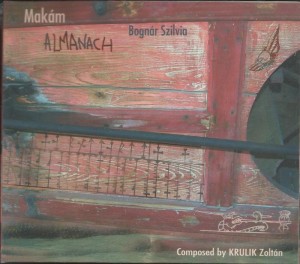 Makám has been putting its own stamp on Hungarian folk music for more than 20 years now. Or rather, Zoltán Krulik’s stamp. Almanach is the first album by this group I have heard, but they’ve been making recordings since 1984. From what I can glean online, numerous Hungarian musicians have cycled through this group in the past two decades, some going on to become quite popular in their own right or to take part in other groups.
Makám has been putting its own stamp on Hungarian folk music for more than 20 years now. Or rather, Zoltán Krulik’s stamp. Almanach is the first album by this group I have heard, but they’ve been making recordings since 1984. From what I can glean online, numerous Hungarian musicians have cycled through this group in the past two decades, some going on to become quite popular in their own right or to take part in other groups.
Currently a sextet, with Szilvia Bognár handling most of the lead vocals, Makám crosses plenty of musical boundaries on Almanach. Krulik writes almost all of their material, much of it in such a way that it sounds very old and traditional; other songs sound like traditional lyrics with a contemporary arrangement; and still others are obviously totally modern compositions. In addition to traditional instruments that you’d expect in Hungarian folk music, such as violin, contrabass, guitars and derbouka drums, here we find clarinets, saxophones (courtesy of guest Sándor Zsemlye), flute, marimba and … on one track, even steel drum. Hungarian calypso? Perhaps.
This CD comes with a booklet that has the lyrics in Hungarian and English, which is a big help in understanding the songs. As you listen, if you follow along with the lyrics, it becomes apparent the great care with which Krulik and Makám have arranged each song. The musical setting nearly always is an ingenious reflection of the mood and meaning of the lyrics, which is no mean trick.
This is especially evident in tracks like “Szél” (wind), which features Bognár as solo vocalist in a lightly jazzy composition, with flute and violin providing instrumental breaks between the verses in 5/8 time; “Ösz” (autumn), with its klezmer-like instrumental breaks of clarinet, violin and soprano sax; “Altató” (lullaby), a gentle song with trilled flute in the background; “Felhos” (cloudy), with a male-female duo on the vocals and atmospheric sounds from a type of pan-pipe; and “Vilharos” (stormy), with its screeching flute and one-two rhythm that sounds like an American Indian dance beat.
Here’s “Ösz.”
Some of the more traditional-sounding songs include the opening track, “Párom Párom” (darling, darling), with its complex rhythm and close female harmonies over simple strummed accompaniment; and “Vándorének” (wanderer’s song), with a simple na-na-na harmonized chorus supporting Bognár’s lead on the verses, which read like traditional folksong: “My cloak’s made from dust of the road / My tall hat from pain and sorrow / My cloak buttons are my sad tears / Sewn from the suffering of years.”
On the other end of the spectrum are songs like “Lassú Ének” (a slow song), which sounds like a Hungarian Pentangle song circa 1973, complete with jazzy bass runs; “Kút Vize” (well water), a Nick Drake-style gentle folk song with Bognár duetting on the vocal with Eszter Krulik, Zoltán’s daughter; and “Holdfényt Vetettem” (I sowed the moonshine). This song is pure psychedelia, a Hungarian It’s a Beautiful Day or Jefferson Airplane song, with a flute and bowed bass intro and wacked-out acid lyrics: “I sowed the moonshine / No harvest was mine / I baked mists of time / No bread did I find.”
An Anatolian influence is evident on a couple of tracks. “Sárga a Repce Virága” (yellow rape flowers are blooming) with its solo vocal by Bognár, backed by violin, flute and derbouka, sounds very traditional; while “Holló-fekete álom” (raven black dream) has a more contemporary sound, with close three-part harmonies and a Turkish jazz sound — a blend of traditional styles and contemporary groove.
The final track is a real curve ball. Titled “Síp ucca, Dob ucca” (Sip Street/Sob Street, or why is the black sea salty?), it’s the only track with a male lead singer. It’s typically jaunty Hungarian folk song, with guitar, bass and a jazzy clarinet behind the droll lyrics about a girl crying in her room by the Danube.
This music is as different as can be from the more traditional Hungarian folk music that other groups have popularized in Western Europe and the U.S., but it springs from the same earthy roots. It’s definitely worth checking out if you’re interested in something utterly original and, to Western ears, quite exotic.
(FolkEuropa, 2004)
